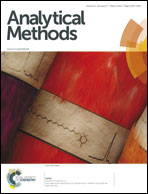Induction of an electrochemiluminescence sensor for DNA detection of Clostridium perfringens based on rolling circle amplification
Abstract
Clostridium perfringens is one of the predominant pathogens causing infectious diseases. This work describes the application of a rolling circle amplification (RCA) based electrochemiluminescence sensor for detection of C. perfringens. Firstly, the target DNA is captured by the probes on the pretreated electrode. Subsequently, RCA reaction is executed isothermally. The products of RCA are incubated with hemin, resulting in the decrease of the ECL emission, which is related to the quantity of the target DNA. The ECL-sensor provides the capability of discriminating the target DNA from non-target sequences even with only one base difference, suggesting an advantageous selectivity. Meanwhile, the lowest concentration of the target DNA is 10−15 M, showing satisfactory sensitivity. Therefore, this strategy combines amplification ability of RCA and high sensitivity of ECL, and enables a low fM detection of C. perfringens without the bacterial culture.


 Please wait while we load your content...
Please wait while we load your content...